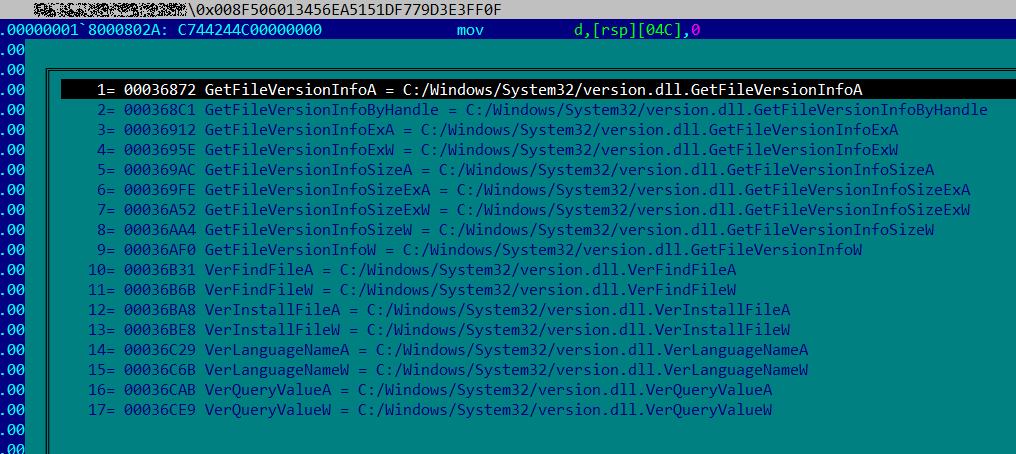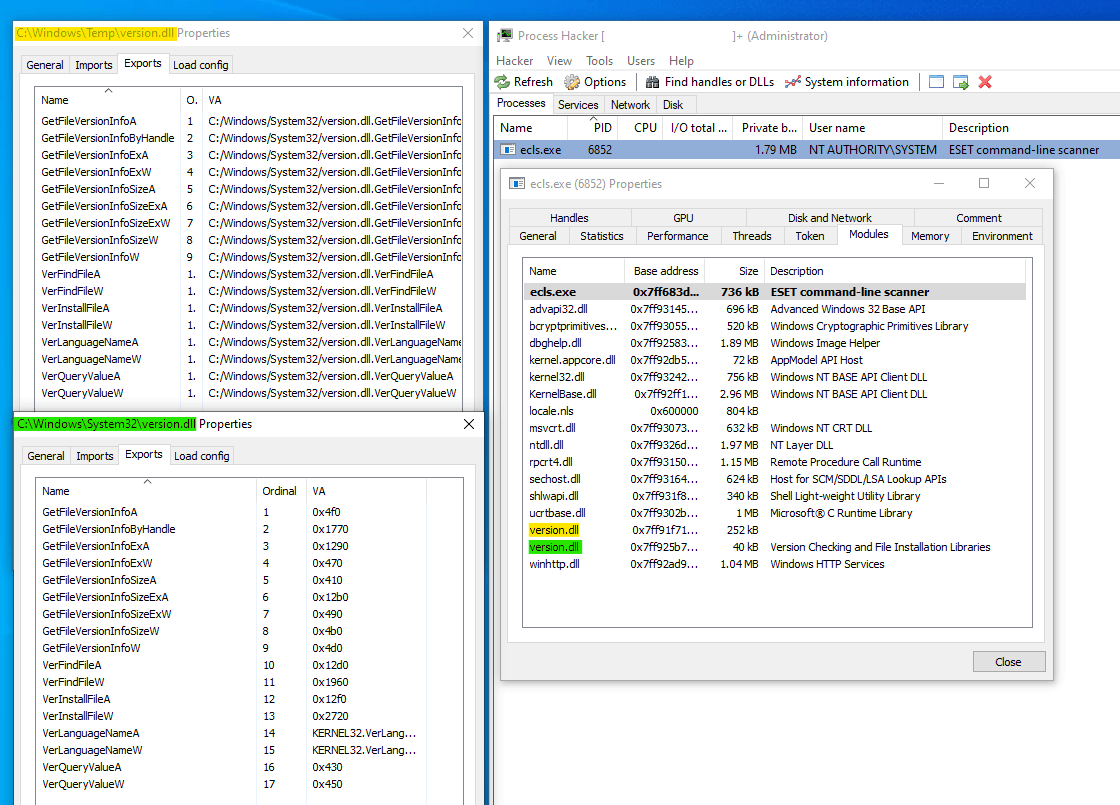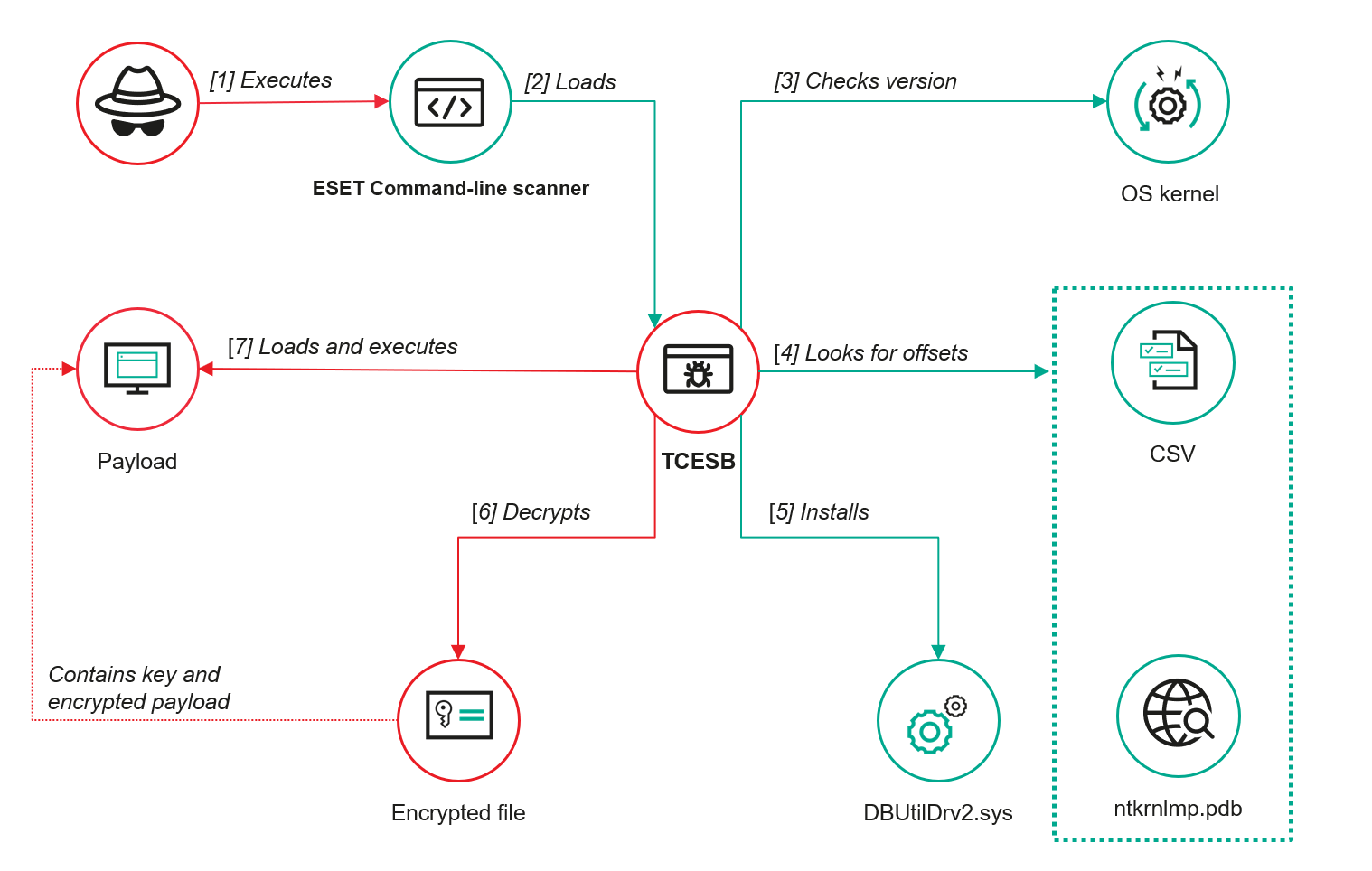Category: ToddyCat APTs - APTs
ToddyCat APT Group
As part of the assignment to analyze an APT group and develop a relevant detection rule, I selected ToddyCAT APT due to its exploitation of a known ESET vulnerability. Since ESET is integrated within our ELK-based SIEM, this made ToddyCAT a relevant and practical choice for deeper analysis, allowing me to align the threat research with our existing security stack.
-
Summary
The ToddyCat APT group, active since at least 2020, has been observed exploiting a vulnerability in ESET antivirus software (CVE-2024-11859) (specifically in the
esets_shellmodule) to stealthily deploy malware.This vulnerability involves insecure DLL search order handling, allowing attackers to load malicious DLLs from unintended directories. The group has used this method to deploy a previously unseen malware dubbed TCESB, designed to execute malicious code undetected and disable Windows kernel-level security mechanisms.
The campaign primarily targets government and defense entities in the Asia-Pacific region.
-
Execution Flow of The Malware

### Normal Execution Flow (Expected Behavior)
- Step 0 (Baseline):
- Legitimate software normally loads a Legitimate DLL.
- It imports required functions directly from the DLL.
### Hijacked Execution Flow (Malicious Behavior)
- Step 1 – Malicious DLL Intercepts
- Instead of the legitimate DLL, a Malicious DLL is placed in a location where the legitimate software will load it first (e.g., same directory).
- The software unknowingly loads this malicious DLL.
- The malicious DLL loads and imports functions from the legitimate DLL to avoid detection.
- Step 2 – Proxy Behavior
- The Malicious DLL forwards function calls to the legitimate DLL.
- This allows it to behave like the real DLL and not break the application.
- While doing this, it can also execute arbitrary malicious code silently.
Researchers have discovered that the APT group ToddyCat, suspected to be linked to China, is exploiting a now-patched vulnerability (CVE-2024-11859) in ESET antivirus software to stealthily load and execute malware on target systems. The vulnerability, fixed in January 2024, stems from insecure DLL search order handling, allowing attackers to trick the system into loading a malicious DLL from an unintended directory instead of a legitimate system file.
Kaspersky reported finding this flaw while analyzing a suspicious
version.dllfile hidden in the temporary folder of an infected machine. The file turned out to be a previously unseen ToddyCat malware dubbed TCESB.TCESB is designed to execute malicious code undetected, featuring capabilities to disable alerts and Windows kernel-level security mechanisms.
- TCESB
- ToddyCat → The APT group responsible for the attack
- Cat → Part of the group’s name
- ESET → The targeted security software
- Sideloading → Refers to the DLL sideloading technique used
- Backdoor → The nature of the malware (it provides remote access/control)
-
CVE-2024-11859
The vulnerability tracked as CVE-2024-11859 affects ESET’s Command Line Scanner (
esets_cmd.exe). It allows an attacker with existing administrator privileges to exploit DLL sideloading by placing a malicious dynamic-link library (DLL) in a specific directory. When the ESET scanner is executed, it loads the attacker’s DLL instead of the legitimate system DLL, enabling stealthy execution of arbitrary code.While this attack does not provide privilege escalation, it abuses a trusted and signed component to evade detection, making it a powerful technique for defense evasion and persistence within compromised environments.
Vulnerability Details:
- CVE ID: CVE-2024-11859
- CVSS v4.0 Score: 6.8
- CVSS Vector:
AV:L/AC:L/AT:N/PR:L/UI:P/VC:H/VI:H/VA:N/SC:N/SI:N/SA:N - Impact: High confidentiality and integrity impact (VC:H, VI:H), local attack vector (AV:L), low attack complexity (AC:L), and requires low privileges (PR:L) with user interaction (UI:P).
This vulnerability served as the main entry point for ToddyCat APT’s TCESB backdoor, enabling them to hijack the execution flow of trusted security software and maintain stealth.
- Step 0 (Baseline):
- Loading The Tools (DLLs)
-
DLL Proxying
Static analysis of the DLL library showed that all functions exported by it import functions with the same names from the system file
version.dll(Version Checking and File Installation Libraries). List of functions exported by TCESB
List of functions exported by TCESBThis indicates that the attackers use a DLL-proxying technique (Hijack Execution Flow, T1574) to run the malicious code.
-
Command Line Scanner
 Malicious and legitimate libraries in the memory of the ecls.exe process
Malicious and legitimate libraries in the memory of the ecls.exe processDuring analysis, researchers discovered a suspicious executable named
eclslocated in the same folder as the TCESB malware. This file, lacking an extension, turned out to be a copy of ESET’s Command Line Scanner. Dynamic analysis revealed thateclsinsecurely loadsversion.dllby first searching in the current directory, making it vulnerable to DLL sideloading.This behavior allowed attackers to load a malicious
version.dll(TCESB) instead of the legitimate system version, leading to stealthy code execution. -
Vulnerable driver
To modify the kernel structures that store callbacks used to notify applications of system events, TCESB deploys the Bring Your Own Vulnerable Driver (BYOVD) technique (Exploitation for Defense Evasion, T1211). It does this by installing a vulnerable driver in the system through the Device Manager interface, using an
INF filewith installation information.
TCESB uses the Dell DBUtilDrv2.sys driver, which contains the CVE-2021-36276 vulnerability. This is a utility driver used to update PC drivers, BIOS and firmware.
-
Launching The Payload

- To detect the activity of such tools, it’s recommended to monitor systems for installation events involving drivers with known vulnerabilities.
- Lists of such drivers can be found on the loldrivers project website, for example. It’s also worth monitoring events associated with loading Windows kernel debug symbols on devices where debugging of the operating system kernel is not expected.
- We also advise using operating system tools to check all loaded system library files for the presence of a digital signature.
- The tool creates its own log file for recording all stages of execution in detail.
 Example of log file contents
Example of log file contents - To detect the activity of such tools, it’s recommended to monitor systems for installation events involving drivers with known vulnerabilities.
-
- Indicators of compromise (IoCs)
- Malicious Files Hashes
- D38E3830C8BA3A00794EF3077942AD96 version.dll
- 008F506013456EA5151DF779D3E3FF0F version.dll
- dacb62578b3ea191ea37486d15f4f83c DBUtilDrv2.sys
- Legitimate file for DLL proxying
- 8795271F02B30980EBD9950FCC141304 ESET Command-line scanner
- Legitimate files for BYOVD
- B87944DCC444E4C6CE9BB9FB8A9C0DEF dbutildrv2.INF
- DE39EE41D03C97E37849AF90E408ABBE DBUtilDrv2.cat
- DACB62578B3EA191EA37486D15F4F83C dbutildrv2.sys
- Malicious Files Hashes
- Detection Rules
- Sigma Rules For ELK
- Search For:
DLL sideloadingesets_cmd.exeversion.dll-
T1574.002(MITRE technique for DLL search order hijacking)title: Suspicious DLL Sideloading via ESET Command Line Scanner (CVE-2024-11859) id: 6d12f5cc-235a-4b64-9c2b-cve202411859 description: Detects potential abuse of ESET's esets_cmd.exe for DLL sideloading (as seen in ToddyCat APT's TCESB campaign) status: experimental author: 0x5l3uth date: 2025-04-13 references: - https://securelist.com/toddycat-apt-exploits-vulnerability-in-eset-software-for-dll-proxying/116086/ - https://attack.mitre.org/techniques/T1574/002/ - https://cve.mitre.org/cgi-bin/cvename.cgi?name=CVE-2024-11859 logsource: product: windows category: process_creation detection: selection: Image|endswith: '\esets_cmd.exe' CommandLine|contains: 'version.dll' condition: selection fields: - CommandLine - Image - ParentImage - OriginalFileName - Company - Hashes - Signature - ProcessId - ParentProcessId level: high tags: - attack.defense_evasion - attack.t1574.002 - cve.2024.11859 - todyycat - eset - dll_sideloading - If you’re using Sysmon, also monitor for:
Event ID 7: DLL Image LoadImageLoadedpath containingversion.dllloaded from unexpected or non-system paths- Parent process =
esets_cmd.exe
- Search For:
- Threat Intel Sharing Platforms
- Search for:
TCESB,ToddyCat, orCVE-2024-11859.
- Search for:
- MITRE ATT&CK Framework
- T1574.002: DLL Search Order Hijacking
- T1055: Process Injection
- T1218: Signed Binary Proxy Execution (living off the land)
- Sigma Rules For ELK
- Resources
- https://attack.mitre.org/groups/G1022/
- https://nvd.nist.gov/vuln/detail/CVE-2024-11859
- https://securityaffairs.com/176364/security/an-apt-group-exploited-eset-flaw-to-execute-malware.html
- https://www.darkreading.com/vulnerabilities-threats/toddycat-apt-eset-bug-silent-malware
- https://support.eset.com/en/ca8810-dll-search-order-hijacking-vulnerability-in-eset-products-for-windows-fixed
- https://securelist.com/toddycat-apt-exploits-vulnerability-in-eset-software-for-dll-proxying/116086/
- https://www.loldrivers.io/drivers/bb808089-5857-4df2-8998-753a7106cb44/
- https://www.loldrivers.io/
- https://www.dell.com/support/kbdoc/en-us/000190106/additional-information-regarding-dsa-2021-152-dell-client-platform-security-update-for-an-insufficient-access-control-vulnerability-in-the-dell-dbutildrv2-sys-driver